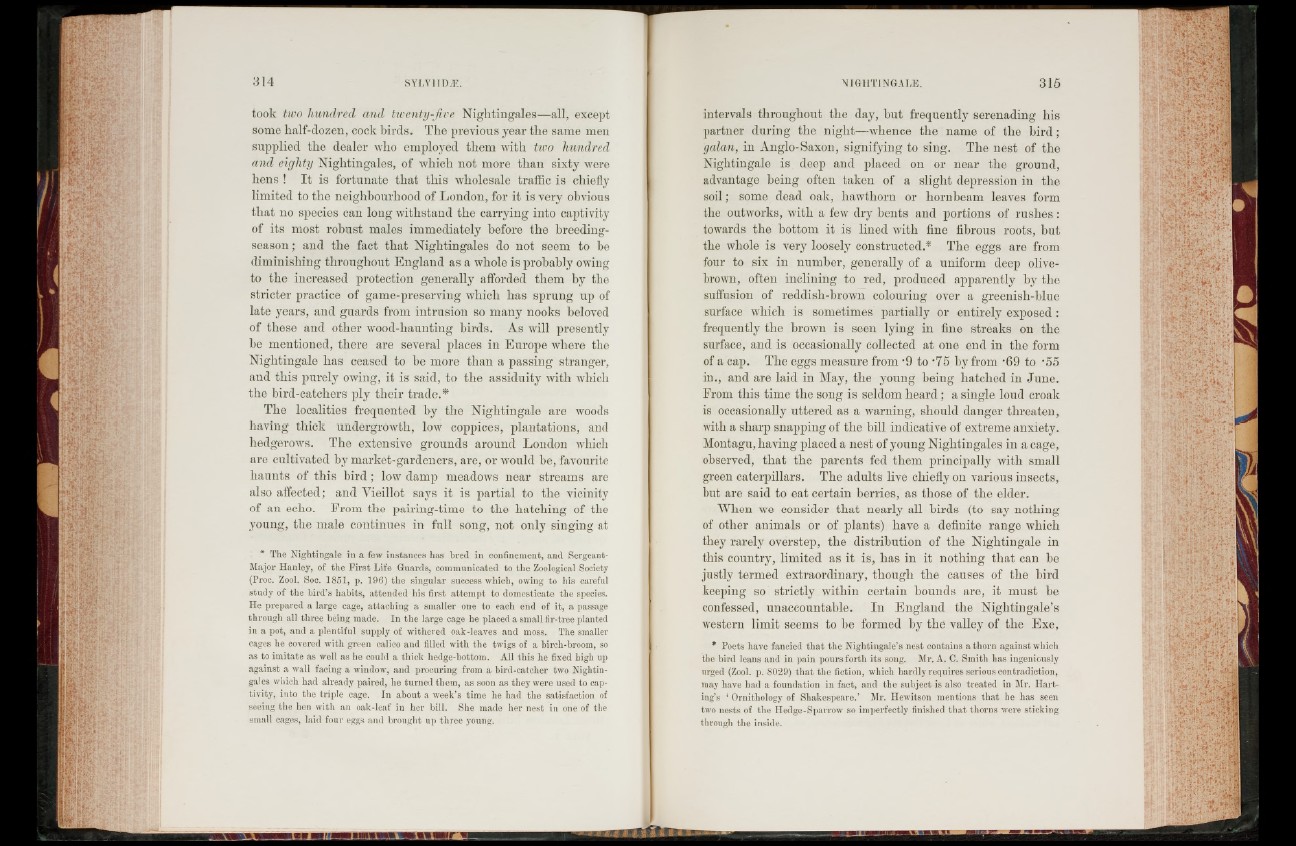
took two hundred and twenty-five Nightingales—all, except
some lialf-clozen, cock birds. The previous year the same men
supplied the dealer who employed them with two hundred
and eighty Nightingales, of which not more than sixty were
hens ! I t is fortunate that this wholesale traffic is chiefly
limited to the neighbourhood of London, for it is very obvious
that 110 species can long withstand the carrying into captivity
of its most robust males immediately before the breediug-
season; and the fact that Nightingales do not seem to be
diminishing throughout England as a whole is probably owing
to the increased protection generally afforded them by the
stricter practice of game-preserving which has sprung up of
late years, and guards from intrusion so many nooks beloved
of these and other wood-liaunting birds. As will presently
be mentioned, there are several places in Europe where the
Nightingale has ceased to be more than a passing stranger,
and this purely owing, it is said, to the assiduity with which
the bird-catchers ply their trade.*
The localities frequented by the Nightingale are woods
having thick undergrowth, low coppices, plantations, and
hedgerows. The extensive grounds around London which
are cultivated by market-gardeners, are, or would be, favourite
haunts of this b ird ; low damp meadows near streams are
also affected; and Vieillot says it is partial to the vicinity
of an echo. From the pairing-time to the hatching of the
young, the male continues in full song, not only singing at
* The Nightingale in a few instances has bred in confinement, and Sergeant-
Major Hanley, of the First Life Guards, communicated to the Zoological Society
(Proc. Zool. Soc. 1851, p. 196) the singular success which, owing to his careful
study of the bird’s habits, attended his first attempt to domesticate the species.
He prepared a large cage, attaching a smaller one to each end of it, a passage
through all three being made. In the large cage he placed a small fir-tree planted
in a pot, and a plentiful supply of withered oak-leaves and moss. The smaller
cages he covered with green calico and filled with the twigs of a birch-broom, so
as to imitate as well as he could a thick hedge-bottom. All this he fixed high up
against a wall facing a window, and procuring from a bird-catcher two Nightingales
which had already paired, he turned them, as soon as they were used to captivity,
into the triple cage. In about a week’s time he had the satisfaction of
seeing the hen with an oak-leaf in her bill. She made her nest in one of the
small cages, laid four eggs and brought up three young.
intervals throughout the day, but frequently serenading liis
partner during the night—whence the name of the h ird ;
galan, in Anglo-Saxon, signifying to sing. The nest of the
Nightingale is deep and placed on or near the ground,
advantage being often taken of a slight depression in the
soil; some dead oak, hawthorn or hornbeam leaves form
the outworks, with a few dry bents and portions of rushes:
towards the bottom it is lined with fine fibrous roots, but
the whole is very loosely constructed.* The eggs are from
four to six in number, generally of a uniform deep olive-
brown, often inclining to red, produced apparently by the
suffusion of reddish-brown colouring over a greenisli-blue
surface which is sometimes partially or entirely exposed :
frequently the brown is seen lying in fine streaks on the
surface, and is occasionally collected at one end in the form
of a cap. The eggs measure from -9 to '75 by from -69 to ’55
in., and are laid in May, the young being hatched in June.
From this time the song is seldom heard; a single loud croak
is occasionally uttered as a warning, should danger threaten,
with a sharp snapping of the bill indicative of extreme anxiety.
Montagu, having placed a nest of young Nightingales in a cage,
observed, that the parents fed them principally with small
green caterpillars. The adults live chiefly on various insects,
but are said to eat certain berries, as those of the elder.
When we consider that nearly all birds (to say nothing
of other animals or of plants) have a definite range which
they rarely overstep, the distribution of the Nightingale in
this country, limited as it is, has in it nothing that can be
justly termed extraordinary, though the causes of the bird
keeping so strictly within certain bounds are, it must be
confessed, unaccountable. In England the Nightingale’s
western limit seems to be formed by the valley of the Exe,
* Poets have fancied that the Nightingale’s nest contains a thorn against which
the bird leans and in pain pours forth its song. Mr. A. C. Smith has ingeniously
urged (Zool. p. 8029) that the fiction, which hardly requires serious contradiction,
may have had a foundation in fact, and the subject is also treated in Mr. Hart-
ing’s ‘ Ornithology of Shakespeare.’ Mr. Hewitson mentions that he has seen
two nests of the Hedge-Sparrow so imperfectly finished that thorns were sticking
through the inside.